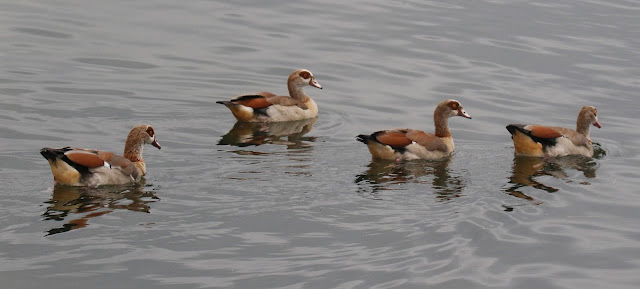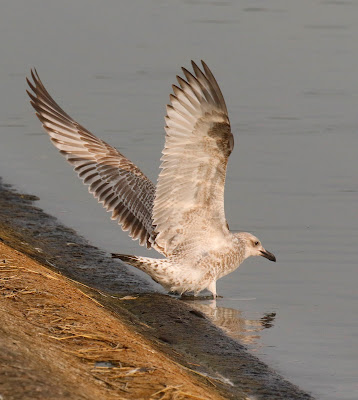I left Isaac on the causeway and went on my way to check the bushes by the banks of the adjacent River Thames, looking for a redstart or maybe a flycatcher. These days, if you are birding you have to be up and about early at the reservoir as it is now far busier than previously, due to many people having 'discovered' during the covid pandemic, that it is a pleasant place for a stroll or to sit outside the cafe with a coffee.
I spent the next six hours scouring every secluded part of the reservoir, searching various hotspots in amongst the brambles, nettles and scrubby areas where hardly anyone ventures.
Standing quietly I soon connected with roving groups of warblers and tits. Each group hurrying through the tops of the hedgerow bushes and trees, playing an avian follow my leader, flying at great speed across the gaps in the hedgerow, constantly apprehensive of the exposure between the sanctuary provided by the bushes. The regular plaintive 'hooeets' of Chiffchaffs and the occasional Willow Warbler, punctuated the progress of these impromptu flocks.
Common Whitethroats. and Blackcaps haunted the brambles, drawn there by the already ripened blackberries, the insistent churring and tacking alarm calls of the respective warblers betraying their hiding places. Once or twice the silvery white and grey form of a Lesser Whitethroat gleamed against the dark leaves and twigs. They are young birds, hatched this year, their clean lines making them svelte and dapper in their fresh plumage.
The weather today was predicted to be dire with heavy rain arriving by nine am but it did not happen and by noon there had been no sign of rain, although the clouds were massing, their grey looming presence dulling the light. I met Dai on the causeway and we stopped to admire a party of Egyptian Geese hanging out with the flock of Greylags and Canadas, that at this time of year like nothing better than to laze away the hours on the concrete that shelves down to the water.
What the..........!
I scrolled back further and found that Isaac had posted a couple of very nice images of a Caspian Gull that he had found on the causeway earlier.The quality of the images showed the gull was viewable at almost point blank range.This was too much for me to resist.
I had to go back to Farmoor, of that there was no question but needed to face the fact that I would get drenched by the unrelenting rain. Undeterred I donned wet weather gear, abandoned any thought of watching the football and headed for Farmoor. The rain remained torrential and mentally I prepared for the worst. I was in for a right good soaking of that there was no doubt as there would be no hiding place on the reservoir. The car's wipers were doing their best to cope with the rain and spray from other vehicles but on approaching the reservoir I was mightily relieved to find the rain ceasing even though it had been predicted to last for the rest of the day. Getting out of the car the rain had completely gone but more dark clouds were heading my way, pressaging another downpour but there was nothing I could do but face it when it arrived.Maybe I could see the gull before the rain was upon me.
I headed up the causeway. One benefit of the rain meant that the causeway was now deserted but for one intrepid couple, so potential disturbance was at a minimum. Sometimes the increased footfall at the reservoir can be so frustrating.You find or see a desired bird at the reservoir only for it to be flushed by innocent passers by. It's not their fault and they have just as much right as anyone to use the reservoir but sometimes............................
It began to rain heavily again. The couple following me took sanctuary in the causeway hide which I had just passed. I carried on. I was on a mission.
There were a couple of likely looking but distant juvenile gulls stood on the causeway wall but on getting closer they were obviously juvenile Herring Gulls. Two thirds of the way up the causeway I saw a bedraggled figure approaching from the opposite direction.It was our esteemed County Recorder, a very wet one and not in the best of moods. He had been caught in the previous deluge with nowhere to shelter and was now getting soaked again. I enquired of any news of the gull and desperate to get to the shelter of the causeway hide he was kind enough to stop long enough to tell me to look for a dead fish on the concrete bank at the top of the causeway.
On reaching the end of the causeway it had almost stopped raining and sure enough two large juvenile gulls were circling a dead trout lying on the concrete bank. But then fate took its turn as two other people, out for a walk, approached the gulls which promptly flew off and settled out on the reservoir. It seemed to take an age for the couple to pass by but when they had one of the juvenile gulls flew back and settled by the fish.
Success! It was the juvenile Caspian Gull and it wasted no time in setting about tearing the trout to pieces with its formidable bill. It was a brutish looking bird, big and bold chested with long legs and an attenuated profile. The second rain shower had now passed and I papped away at the gull which showed remarkable trust, allowing me to approach it closely. All was well until two of the Egyptian Geese walked along the concrete and stood right beside the gull effectively obscuring it.Thanks! I felt sure the gull would fly off but not a bit of it.The gull held its ground and continued to feed as the geese, which can be quite aggressive to other birds, ignored it.
I walked around the reservoir perimeter with two birding colleagues who had joined me, all of us eventually coming to rest on the perimeter wall, a few metres from the gull and for the next hour stood admiring this unexpected and welcome encore to my birding day. By now the wet weather had long gone and a sultry and humid atmosphere settled over the water with even sunny spells piercing the skies.In my wet weather gear I now felt decidedly overdessed!
The Caspian Gull had one purpose on its mind and that was to eat as much of the fish as possible.Eventually there was nothing left of the fish but skin and bones, all the flesh consumed.
The gull now replete, flew a short way out onto the water and settled. I swear it looked thoroughly pleased with itself.
Caspian Gulls core breeding areas are around the Black and Caspian Seas and across central Asia to nothwest China.Their population is expanding and it has been spreading north and west and now breeds as near to Great Britain as Poland and Germany. Sightings of colour ringed birds in Great Britain indicate that it is birds from these areas that are wandering to Great Britain, where they can be found mainly in the southeast, East Anglia and the Midlands. Increasingly, British birders are acquiring the expertise to differentiate this gull from other similar species of gull. This is reflected in the increasing number of records of this species from Britain. Although its population is increasing it is still a comparatively rare bird in Great Britain and often a challenge to identify - hence all the excitement amongst certain birders at Farmoor Reservoir today.

















No comments:
Post a Comment